Weights and Measures
- sulla80

- Aug 3
- 20 min read
Updated: Aug 14
Today's post begins with the hope of making some sense of the weight standards for a set of staters in my collection. A number of questions started this deep dive:
What weight standards did the ancient Greeks use for ancient Greek coins?
Why are these standards named the way they are today?
What sources are the most useful to understand these standards?
When did each standard come into use and who initiated the standard?
What are the the various denominations used for ancient Greek coins and what was their weight under each of the standards?
Greek Staters
Here are a few coins from my collection that I have labelled as "Stater" : The Greek word στατήρ (statḗr) derives from the verb ἵστημι (hístēmi), meaning to make stand, to set upright, or to weigh out evenly. The term appears in Greek sources from the Archaic period onward and originally referred to a standard weight, a mass that would "stand in balance" against another on a scale.

As you can see from the examples above the weights of these "staters" range from 123.5g to 7.65g - so what defines a "stater". How could these all be staters? What defines a stater.
The word στατήρ / stater derives from ἵστημι (hístēmi): "to cause to stand, set, place in the balance, weigh." "That which is weighed / the balance weight," a weight even before it became a coin.
The coins above are all staters based on 3 or 4 different weight standards.

Ancient Greek Coin Standards
From Aegina’s silver “turtles” to Athens’ famous “owls,” ancient Greek coinage operated on several distinct weight standards. These standards: Attic, Aeginetan, Corinthian, Phoenician, Chian, Rhodian, Cistophoric, Persian, and more, defined the weight of each coin denomination and evolved over time with trade and shifts in power.
Greek city-states did not share a single currency system; instead, each major trading power established its own weight standard for coinage, usually anchored to a specific drachma or stater weight. Over centuries, economic needs, political hegemony, and alliances drove the adoption, adaptation, or abandonment of these standards.
There are a few earlier "standards" that I will only briefly summarize:

Early electrum standards such as the Milesian (~14 g), Phokaic (~16 g), and Samian (~13 g) are only touched on because they were short‑lived, regionally confined to archaic Ionia, and almost entirely superseded by the later silver‑based standards that shaped Classical and Hellenistic commerce.
Ultimately Greek coins and standards were driven by the need to trade, fund wars and influence in the ancient Mediterranean world.
"Along the northern coasts of the Aegean from Byzantium in the east to Macedon in the west, especially among the semi-barbarous mining tribes of the metalliferous highlands of the Pangaean district and in Thasos, two similar standard are met with in the silver coinage, both before and after the Persian wars, and, in fact, down to the reorganization of the currency by Philip after his exploitation of the prolific mines at Crenides."
-Barclay Vincent Head, 1911Historical Context & Economic Drivers
In the early 6th and 5th centuries BC, as coinage spread through the Greek world, each region initially struck coins on its traditional weight units. These units were inherited from older systems of weights and measures (often tied to local trade goods or influences from the Near East). No central authority imposed a uniform standard, so Aegina, Corinth, Chios and Athens all developed coins of different weights. A one-drachma coin in one city might contain significantly more silver than a “one-drachma” coin elsewhere. Such disparities were not arbitrary - they reflected local economic drivers. Aegina, a maritime trading power, issued heavy silver coins to support large transactions in the late Archaic trade networks, while Corinth’s lighter coins aligned with the needs of its western colonies and trade in the Adriatic.
Despite this patchwork of standards, economic forces pushed towards harmonization over time. When coins from one city-state (notably Athens) gained wide acceptance due to trusted weight and purity, other states found it advantageous to adjust their own coin weights for compatibility. Conversely, competition and local pride could inspire the creation of a distinct standard to bolster regional autonomy. The politics of power and alliances also played a role:
It is often said that the dominant power Athens mandated the use of Athenian “coins and weights and measures" in the 5th century.
"and the secretary of the Council [and People?] is to add the following to the oath of the Council: if anyone strikes silver coinage in the cities and does not use the coins of the Athenians or their weights or measures, but foreign coins and weights and measures . . ."
Attic Inscriptions Online: OR 155 circa 414 BC? (See also IG I³ 1453)In “Deconstructing a Prussian Myth: The Athenian Standards Decree (IG I³ 1453 a–g)” Psoma reassesses the Athenian Standards (or Coinage) Decree, a mid‑fifth‑century BC inscription traditionally taken to mean that Athens forbade her allies to strike their own silver coinage and forced them to use Attic weights, measures, and “owls.” She labels that reading the “Prussian myth.”
Ulrich von Wilamowitz‑Moellendorff (1880) first connected Aristophanes Birds 1040‑41 with scattered fragments of the decree and, influenced by the newly unified German monetary system of 1871, reconstructed an imperial Athenian ban on local minting - an idea eagerly adopted by subsequent epigraphists and numismatists.
Psoma argues compellingly against this interpretation :
Hoards inside imperial territory contain few “owls”; large owl hoards are Persian‑controlled or post‑war deposits
Several allies (e.g., Samos, Chios, Thracian cities) continue minting well after supposed ban
Clause 10 could not impose death‑penalty oath as the council could not impose such penalties; oath more plausibly guarantees fair conversion of non‑Attic coin at a set fee
She argues that ththe purpose is a technical fiscal by‑law of autumn 413 BC, contemporaneous with the eikostē (5% customs duty) imposed after the Decelean occupation; the weights & measures clause added so the new tax could be assessed uniformly.
Major Weight Standards

Aeginetan Standard: The Aeginetan standard originated with the island of Aegina, traditionally the first Greek state to strike silver coins (its early 6th-century BC “turtle” staters). This standard was heavy: a drachma was ~6.2g, and the main coin was a silver stater of about 12.4g (technically a didrachm, or two-drachma piece).
Each drachma was divided into 6 obols of roughly 1.0g. The name comes from Aegina’s Greek name and a later tradition that *heidon of Argos had established Aegina’s weights. Modern scholars like Vincent Barclay Head adopted “Aeginetan” to describe this widespread Archaic standard. In the 6th century BC, Aeginetan-weight coins were dominant in Aegean trade. Many Peloponnesian and central Greek mints (e.g. Thebes, Corinth’s colonies in Acarnania, and various Cycladic islands) issued their currency on the Aeginetan standard in that era.
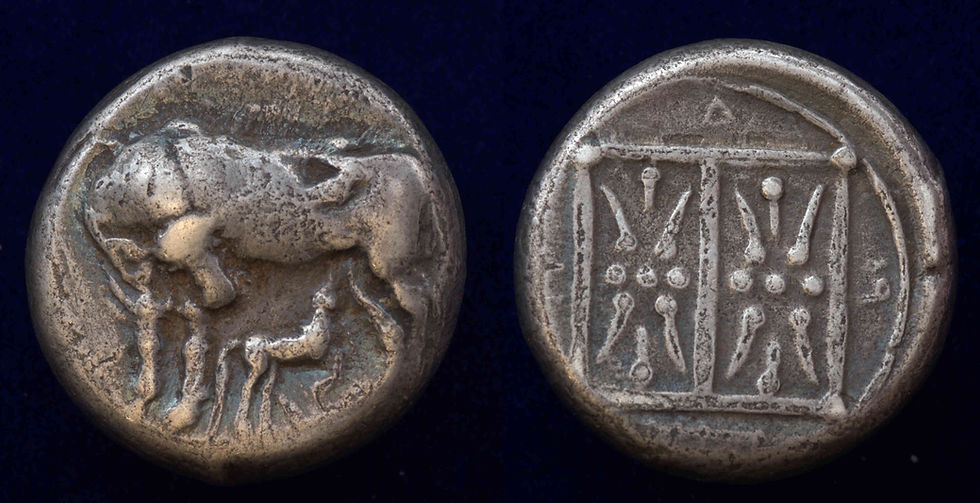
The prominence of the Aeginetan standard began to wane in the 5th century as the Attic standard rose under Athens’ empire. Nevertheless, Aeginetan weight coinage persisted in many regions (Sparta and allies, and in some Hellenistic contexts) into the 3rd century BC. The Dyrrhachion staters of c. 340‑280 BC are ~11g and are on the weight standard of Illyrian or Corcyra‑Dyrrhachium standard a reduced‑Aeginetan standard. The Achaean League around 200 BC adopted a reduced Aeginetan standard (the Symmachikon, or “Allied” standard) to facilitate a common currency among former Aeginetan-standard cities.
Denominations: 1 obol ≈ 1.0g; 6 obols = 1 drachma ≈ 6.2g; 1 stater = 2 drachmae ≈ 12.4g.)

Attic Standard (Athens/Euboic):The Euboic standard was based on a silver drachma of about 4.3g, with six obols (small units, ~0.72g each) to a drachma. In practice, the chief coin was the silver tetradrachm (four drachmas) at ~17.2g. First adopted by Athens in the late 6th century BC, this standard likely evolved from the Euboic standard of Euboean cities (Chalcis, Eretria) that traded in the region. The island of Euboea is located north of Athens and modern scholars often use “Attic” and “Euboic” interchangeably to refer to this standard. The name “Attic” highlights Athens’ dominant role in popularizing the standard.
According to Aristotle, the lawgiver Solon introduced the Euboic standard in place of the older Aeginetan standard facilitating trade after 594 BC. Modern scholars debate the historicity of Solon’s role, but agree Athens adopted the lighter Euboic/Attic standard by the late 6th century.
In the Athenian Constitution, Aristotle discusses the reforms of Solon (c. 640–560 BC) an Athenian nobleman, poet, reformer, archon eponymos in 594/3 BC credited with setting up the timocracy, a system of government where wealth not birth determine political status. In a moment where Athens teetered on civil war, Solon found a path that relieved the debts of the poor, preserved the rights of the noble families, and instituted structural reforms that redefined Athenian civic life without dismantling its aristocratic core.
ἦν δ᾿ ὁ ἀρχαῖος χαρακτὴρ δίδραχμον. ἐποίησε δὲ καὶ σταθμὰ πρὸς τὸ νόμισμα, τρεῖς καὶ ἑξήκοντα μνᾶς τὸ τάλαντον ἀγούσας, καὶ ἐπιδιενεμήθησαν αἱ τρεῖς μναῖ τῷ στατῆρι καὶ τοῖς ἄλλοις σταθμοῖς.
-Aristotle, Athenian Constitution, 10.1Translated:
“Now the early coin type was the didrachm. And he [Solon] also established weight standards for the currency: the talent was to be equivalent to sixty-three minae, and the three minae were assigned to the stater and to the other denominations.”
-Aristotle, Athenian Constitution, 10.1The modern label “Attic” reflects Athens’ role in popularizing it. Athens’ abundant silver mines at Laurion and stable political weight ensured that “Attic” coins (notably the owl-stamped tetradrachms) became internationally trusted currency. By the Classical period, the Attic standard was interchangeable with the Euboic and had spread via Athenian trade and the conquests of Alexander the Great, who minted his empire’s silver on the Attic standard from 333 BC. Most Hellenistic kingdoms (Seleucid, Antigonid, etc.) followed suit, making Attic the dominant standard of the Eastern Mediterranean.
Denominations: 1 obol ≈ 0.72g; 6 obols = 1 drachma ≈ 4.3g; 1 tetradrachm = 4 drachmae ≈ 17.2g.

Corinthian (or “Corcyraean”) Standard: Corinth, a wealthy trading city, developed its own standard in the late Archaic period. The Corinthian system’s basic coin was the silver stater (often bearing Pegasus), weighing about 8.6. This was equal to half an Attic tetradrachm. Unique to Corinth, the stater was subdivided not into two drachmas but into three nearly equal parts of about 2.9g each. Modern numismatists often call those subdivisions “drachmas,” though they are lighter than the Attic drachma. The term “Corinthian” standard is thus defined by a tridrachm stater of 8.6g (3 × 2.87g).
Corinth’s colonies in northwestern Greece and Sicily (e.g. Corcyra in the Adriatic, Syracuse initially) adopted similar weights, which is why older literature sometimes labels it the “Corcyraean” standard.
Early Classical hoards show Corinthian staters circulating alongside Attic coins, suggesting their weight was deliberately compatible: two Corinthian staters (2 × 8.6g = 17.2g) matched one Attic tetradrachm. Corinthian weight coins were produced in vast numbers, fueling trade and mercenary payments in the Western Greek world until the 4th century BC. Corinth’s standard may have been devised to ease exchanges with both the Attic standard to its north and the Aeginetan standard to its south. Two Corinthian drachmas (~5.8 g) were close to half the weight of an Aeginetan stater (~12.2 g).
Denominations: 1 “drachma” ≈ 2.9g; 3 drachmas = 1 stater ≈ 8.6g.
In Italian Greek colonies (Achaean standard or reduced Aeginetan standard an off shoot of the Corinthian standard), 1 stater ≈ 8.0g divided into 3 drachms of ~2.6g.)
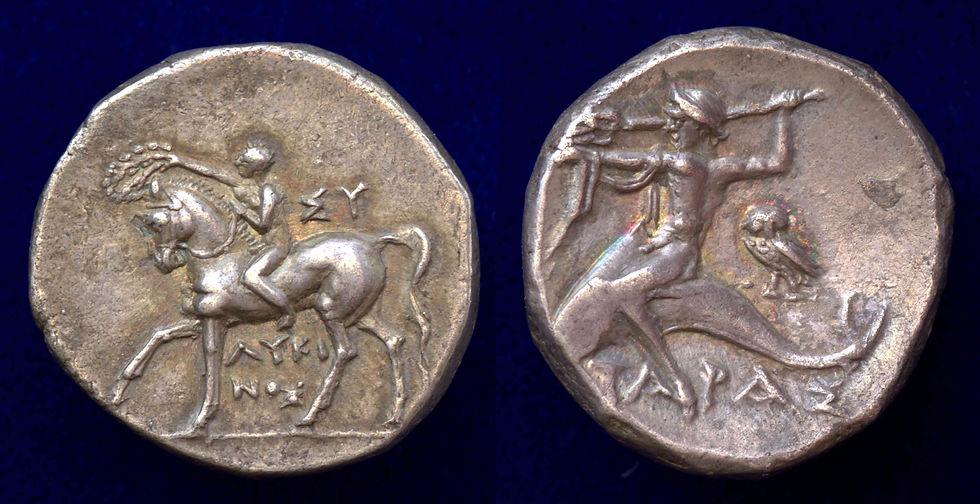
Tarentum used the Achaean standard and the coin above can be called a stater, nomos or didrachm depending on the preferences of the cataloger.

Phoenician Standard: The Phoenician (or shekel) standard was common in the Levant and among Phoenician-influenced regions. Its unit was the silver shekel (Hebrew shekel, Greek siglos), roughly 7.0-7.3g. In the 5th-4th centuries BC, cities like Tyre, Sidon, Byblos, and the Phoenician colonies (e.g. Carthage) issued shekel coins of this weight. A double-shekel or didrachm of ~14.5 also appears, especially in the coinages of Persian-ruled states. Modern scholars named it “Phoenician” because of its use in those cities, though it likely derives from older Near Eastern standards. Notably, the northern Greek Chalcidian League in the late 5th century adopted a “Phoenician” tetradrachm of ~14.2-14.5g for their federal coinage.

Philip II of Macedon initially struck his famous tetradrachms on this standard (~14.5g) in the mid-4th century, aiming to facilitate trade with Thrace and the Levant, before Alexander’s reform. After Alexander’s conquests (late 4th century), the Attic standard supplanted the Phoenician for new coinage.

In the Hellenistic period, the Phoenician standard persisted in a reduced form for certain regions: both the Seleucid and Ptolemaic kingdoms, when minting silver in Phoenicia and Coele-Syria, used a “Phoenician” shekel of ~7.1g (essentially a Ptolemaic didrachm). This illustrates how a venerable standard was adapted within larger empires’ currency systems.
Denominations: 1 shekel ≈ 7.2g; 1/2 shekel ≈ 3.6g; double shekel ≈ 14.4g.
In the early 4th century BC the Chian standard’s drachm, first conceived at ~3.8 g, was drifting down toward ~3.5 g across western Asia Minor; my coin at 3.59 g sits right in that reduced 4th‑century band.

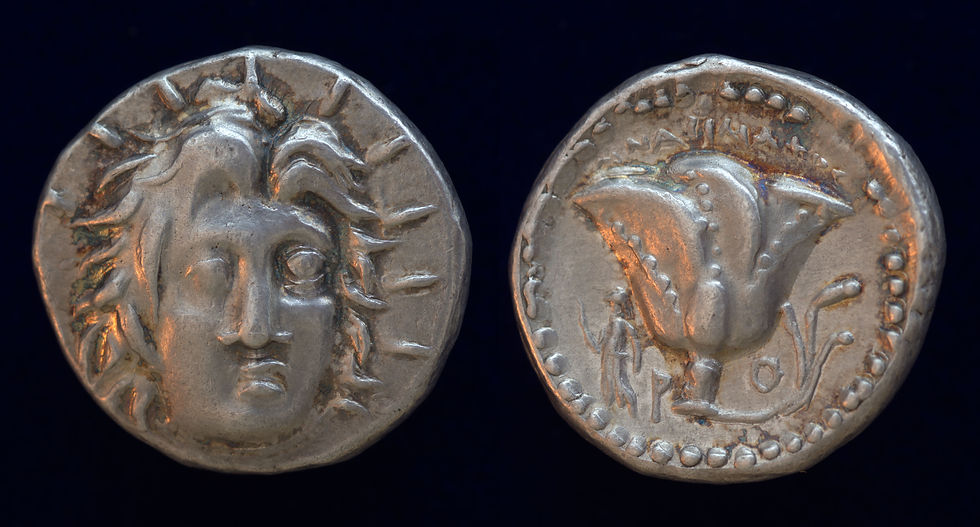
Chian Standard: Named after the Aegean island of Chios, the Chian standard was a high-weight system that emerged in the 5th century BC. It was based on an ideal silver stater of approximately 15.6g, although Chios initially issued only fractions of that unit. In the early 5th century, Chios and some Ionian neighbors struck half-staters of ~7.8g and tiny sixth-staters (or hectē) of ~2.6g. The origin of this standard likely connects to Chios’s thriving wine export economy and perhaps influence from the old Lydian/Babylonian standards (a Babylonian shekel ~8g makes a 16g stater).
Modern terminology “Chian” comes from Chios, but interestingly ancient evidence (coins and weights) suggests this standard spread widely in the 4th century BC beyond Chios. By the mid-4th century, Rhodes had adopted the Chian weight for its coinage, as did cities in Caria, Ionia, the Propontis, and the Cyclades. One catalyst was Sparta’s alliance with Chios during the Peloponnesian War: Chios financed Spartan naval operations with Chian-standard coins, and Lysander encouraged other allies to mint on this standard for interchangeability. After Alexander’s time, Chios itself abandoned its standard in favor of Attic, but Rhodes and successor states modified it into what became known as the “Rhodian standard.”
Denominations: 1 tetradrachm (sometimes referred to as a stater) ≈ 15.6g; 1/2 stater (didrachm) ≈ 7.8g; 1/2 stater or drachm ≈ 3.9g; 1/6 stater (tetrobol = 2/3 drachm) ≈ 2.60g; 1/8 stater (hemidrachm/triobol = 1/2 dr.) ≈ 1.95g. Note that the stater = 4 drachms; drachm = 6 obols.(In practice, many early-4th-c. issues are modestly light: drachm ≈ 3.5–3.7g; stater ≈ 14.0–15.0 g; tetrobol ≈ 2.3–2.5 g).


Rhodian Standard: Around 300 BC, the island republic of Rhodes (which had originally used the Chian standard) introduced a reduced weight standard to better suit its economic sphere. The Rhodian standard’s silver tetradrachm weighed about 13.4g, but notably the Rhodians preferred to mint mostly didrachms of ~6.7g and drachms of ~3.35g. Over time, the tetradrachm was phased out and the didrachm (sometimes called a Rhodian stater) became the principal coin.
The modern name comes from Rhodes, but this standard can be seen as a continuation of the Chian system at a roughly 15% reduced weight. It gained wide circulation in the Eastern Mediterranean during the Hellenistic period, especially in areas under Rhodian commercial influence. By the late 4th century BC, coinages in the Aegean tended to be either on the Attic or the Rhodian standard. Even the Ptolemaic Kingdom briefly struck coins on the Rhodian (Chian) standard during the 310s BC, before instituting its own system. The Rhodian didrachm became a popular trade coin (particularly for commerce in wine and grain), often circulating alongside slightly lighter Lycian league coins at parity.
Denominations: 1 drachm ≈ 3.35g; 2 drachms = 1 didrachm ≈ 6.7g; 4 drachms = 1 tetradrachm ≈ 13.4g (early issues).

Issued by Lucullus in Ephesus celebrating the end of the 3rd MIthridatic War
Cistophoric Standard: In the 2nd century BC, the Attalid dynasty of Pergamon created a localized weight standard for a new coin called the cistophorus (named for the sacred basket, cista, depicted on it). Introduced c. 190 BC after Rome defeated the Seleucids, the cistophorus was a tetradrachm weighing only ~12.6g. This was roughly 3 Attic drachmas’ worth of silver, not four—suggesting the coin was valued at four drachmas in Pergamene reckoning but contained less metal. The cistophoric standard spread across western Asia Minor (Mysia, Lydia, Caria) under Attalid and later Roman administration, remaining in use until the 1st century AD. In this system, a didrachm (half cistophorus) was ~6.3g and a drachm ~3.15g. The rationale was likely to create a closed currency zone to prevent Attic-standard tetradrachms from overwhelming local money; effectively, the Attalids minted “lighter” tetradrachms that were tariffed at a high value for local use. Modern numismatists label this the cistophoric standard after the coin.
Denominations: 1 cistophorus (tetradrachm) ≈ 12.6g; 1 didrachm ≈ 6.3g; 1 drachm ≈ 3.15g.
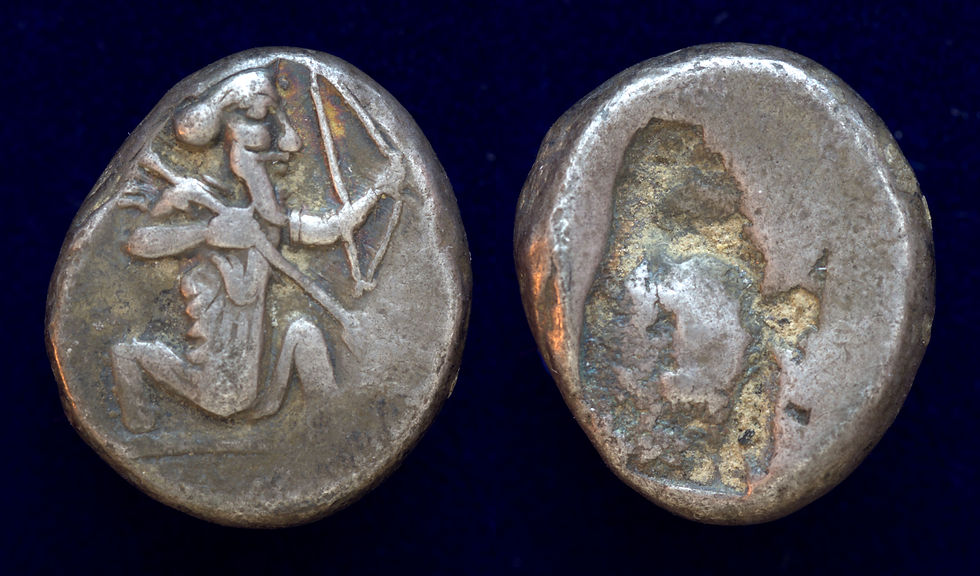
Persian/Persic Standard (Siglos): Beyond the Greek cities, the Achaemenid Persian Empire established a bimetallic weight standard in the late 6th century BC under Darius I. The Persian system’s gold coin was the daric (about 8.4g of gold), and its primary silver coin was the siglos (Old Persian shekel, about 5.6g of silver). Twenty silver sigloi were roughly equivalent in value to one gold daric. While these Persian coins were not Greek, their weight standard influenced Greek coinage in Asia Minor.

Several Greek cities under Persian rule or influence (such as Colophon, Lycia, Tarsus, and others along the coast) issued local silver coins on the Persian standard - typically drachms of ~5.5g or didrachms of ~11g to mirror the siglos and double-siglos. For instance, in the early 4th century, the satrap Pharnabazos and cities in the Troad minted “Persic” weight coins for mercenary pay. The term “Persian standard” today denotes coinages that follow the sigloi weights.
This coin from Cilicia Casabonne Type 4 - the winged male/solar‑disk & swan series from Mallos - forms a unified weight group that he labels “Série au standard persique”; its range in weight, iconography, and dating (c. 440‑390 BC) align precisely with the peak of Persian naval activity on the south‑Anatolian coast.

Side, in Pamphylia, also lay inside the Cilician satrapy; its harbor provisioned Persian fleets. Imperial paymasters issued and accepted silver by the siglos. Cities that wanted their own civic types therefore coined the two‑sigloi piece so that soldiers and merchants could spend it without a fee. From 412 BC onwards Pamphylia returned to direct Achaemenid control; satraps paid fleets and mercenaries in sigloi multiples.
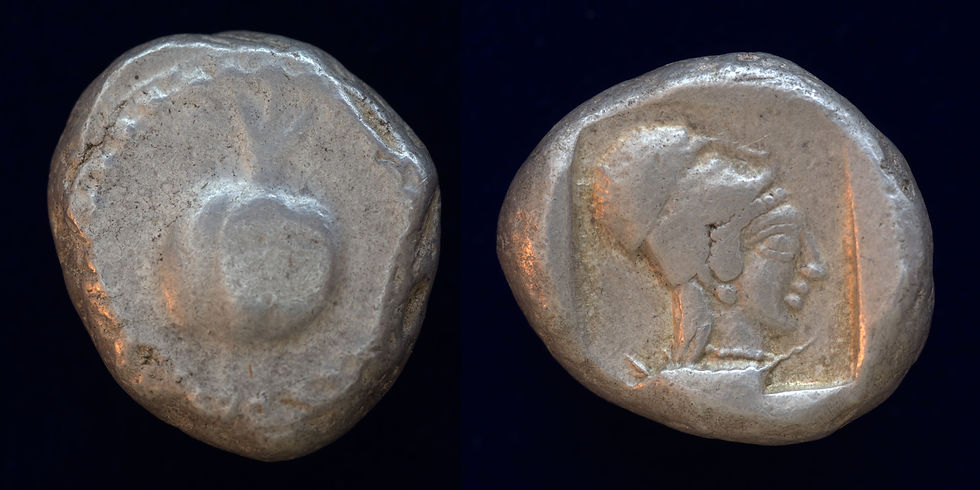
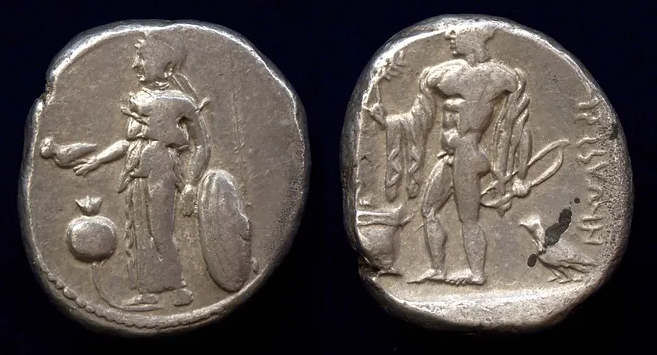
Side, Aspendos and Kelenderis staters were interchangeable and struck on a shared standard. The classical‐period staters of Aspendos are also on the Persic (Achaemenid) standard. Aspendos lay inside the Achaemenid satrapy of Cilicia-Pamphylia. Achaemenid administrators paid troops and levied taxes in sigloi they therefore adopted the two-sigloi unit.


After Alexander’s conquest of Persia (330s BC), the daric/siglos currency was phased out in favor of Attic-weight coins.

However, intriguingly, in the late 4th and 3rd centuries BC some Black Sea Greek cities and Hellenistic dynasts reintroduced or retained the Persian silver standard for certain issues. This occurred in regions where Persian influence lingered or where a lighter coin was expedient for local trade.

Denominations: 1 siglos ≈ 5.6g; 2 sigloi ≈ 11.2g; gold daric ≈ 8.4g.
Here's a summary table of the standards reviewed above:

Patterns of Adoption, Decline, and Interchange
Throughout antiquity, these standards rose and fell in prevalence like currencies in competition. In the Archaic period (6th century BC), the Aeginetan standard reigned as the primary international currency: Aegina’s large, thick silver staters circulated widely, and many regions imitated that weight for compatibility.
Soon after, Athens’ choice of the Attic (Euboic) standard set it on a different path -one that would eventually dominate. According to later Greek memory, Solon’s 6th-century reforms in Athens replaced “the Aeginetan weights” with Euboic/Attic ones, immediately lightening the drachma by ~30% (from ~6g to ~4g). This made Athenian coins lighter (i.e. a given value required less silver), a change possibly aimed at encouraging trade by matching the coinage of Euboean colonies in Asia Minor.
By the Classical period (5th–4th centuries BC), Athens leveraged its political power to spread the Attic standard. The Coinage Decree of Athens (c. 449 BC) ordered allied states to use only “Athenian coins, weights, and measures,” penalizing local minting. While enforcement of this decree is debated, Athens undeniably succeeded in making its Owl tetradrachms the preferred coinage for trade and mercenary pay across the Aegean. An illustrative anecdote: the silver “owls” from Athens’ Laurion mines not only paid for triremes at Salamis but later funded major projects like the Long Walls fortifying Athens’ port - literally concrete evidence of monetary standard enabling imperial infrastructure. In tandem, other Greek powers maintained their standards: e.g. Corinth and the West stuck to the Corinthian tridrachm system, which facilitated exchange within their own colonies. When Sicilian cities like Syracuse issued Corinthian-weight coins, it affirmed how a common standard eased commerce within cultural spheres.
The late Classical to early Hellenistic era (4th century BC) witnessed a convergence of standards due to empire-building. In the 370s–360s BC, the northern Greek kingdom of Macedon experimented with the Phoenician standard (Philip II’s tetradrachms of ~14.5g) to pay Thracian troops. But the decisive turn came with Alexander the Great (r. 336–323 BC). Upon conquering the Persian Empire, Alexander unified coinage on the Attic standard - striking vast emissions of silver Alexandrian tetradrachms (~17g) that replaced diverse local issues.
By 300 BC virtually all major mints had shifted to Attic weight for silver, except two main holdouts: Ptolemaic Egypt and independent Rhodes. (In Egypt, the Ptolemies deliberately issued a “closed” coinage on a reduced standard of ~14.2g to the tetradrachm, ensuring foreign Attic coins wouldn’t intermingle; Rhodes, as noted, used its own standard tied to regional trade in the East.
This broad homogenization under Attic weight greatly facilitated long-distance trade and finance. A merchant in 250 BC could accept a Seleucid tetradrachm in Antioch and spend it as an equal value to a Macedonian or Athenian tetradrachm in Delos, without needing to weigh and compare different standards. Still, Attic dominance did not mean absolute uniformity. Regions on the fringes or with special circumstances continued to innovate.
Western Asia Minor, under Pergamene rule, adopted the cistophoric standard (~12.6g tetradrachms) in the 2nd century BC as a kind of customs union currency. Likewise, federations like the Achaean League in Greece adjusted the old Aeginetan standard down to about 10g staters (a symmachic standard) to streamline coinage among their cities. These cases show conscious weight reductions to define a monetary zone where outsiders’ heavier coins had to be exchanged - an ancient form of protecting economic autonomy.
Interchange between standards was typically managed by money-changers (trapezitai), who used scales to weigh foreign coins. In many commercial cities (e.g. Athens, Corinth, later Delos), bankers would accept off-standard coins by weight, sometimes melting them down to re-mint local issues. Rates of equivalence were sometimes officially set - for instance, an inscription from 4th-century Cyrene fixes a trade ratio between Attic and local coin weights, and the Athenian law of 375 BC required all silver coins of good metal (even if foreign weight) to be accepted at the mint or market by weight. (AIO 819)
Hoard evidence confirms mixed-standard circulation: for example, late Hellenistic hoards in the Near East contain Attic-standard tetradrachms alongside lighter Rhodian and even cistophoric pieces, suggesting they circulated together with value adjustments. Over time, however, the habit of weight reduction (mints striking coins a fraction lighter than their predecessors to save bullion) caused even Attic-standard coins to drift downward in weight. By the 1st century BC, an “Attic” drachma was closer to 4.2g and many older standards had effectively converged or disappeared as Roman coins (the denarius, etc.) took center stage.
In summary, the map of Greek weight standards is one of initial diversity giving way to gradual convergence, driven by the efficiencies of trade and the realities of empire. Yet, local pride and practical concerns left their mark in the form of distinctive systems like the Aeginetan, Chian/Rhodian, or cistophoric, each with its own story of rise and decline. The terminology we use - “Attic,” “Aeginetan,” “Rhodian,” etc. - was mostly coined by modern scholars for convenience, but it underscores the critical fact that money was never just money in antiquity; it was a city’s standard, as much a part of its identity as its patron deity or dialect.
Conclusion / Contemporary Relevance
Ancient Greek weight standards may seem like minutiae, but they illuminate how economic connectivity and political power were negotiated through currency. The existence of multiple standards required ancient merchants to be savvy in conversion and gave political leaders a tool to project influence (as when Athens’ owls became the “international trade dollar” of the 5th century BC).
Today, historians and numismatists use these standards to authenticate and date coins, understanding that a delta of a few tenths of a gram can signal a new era or authority. In a broader sense, the interplay of Athenian, Aeginetan, and other standards reminds us that even in antiquity there was a prototypical form of monetary globalization - with all its challenges and innovations.
Just as modern currency zones simplify trade, the ancient shifts toward the Attic and Rhodian standards presaged the advantages of interoperability, while the persistence of local standards speaks to the enduring desire for monetary sovereignty. In our ever-globalizing economy, the study of these long-ago weight standards is a scholarly detective story that also offers a mirror on today’s balance between unified systems and local autonomy.
References:
Inscription IG I³ 1453 (the “Athenian Coinage Decree” also here: IG I³ 1453). A 5th-century BC Athenian inscription either mandating the use of Athenian coins and standards by allies or ensuring consistency in exchange rates. Fragmentary but critical for understanding Athens’ assertion of the Attic standard.
Inscription AIO 819 (Law on approvers (dokimastai) of silver coinage, 375/4 BC). Nikophon proposed to accept Attic silver coin when it is determined to be silver and bears the public stamp. Established enforcement and rules around the acceptance of Athenian owls.
Thucydides. "Histories", 8.101. Thucydides records that in 407 BC, Chios gave financial support to Sparta; this is primary evidence of Chian-standard coin moving between allies. Cited to illustrate how wartime exigencies spread a weight standard beyond its home.
Herodotus. Histories (esp. 3.89-3.95). Describes Persian tribute in talents, comparing Babylonian and Euboic (Attic) weights. Provides rare contemporary quantification of weight differences (Babylonian talent = 70 Euboic minae). Herodotus documents the awareness of multiple standards in the 5th century BC.
Ridgeway, William. The Origin of Metallic Currency and Weight Standards. Cambridge: Cambridge University Press, 1892. References Julius Pollux, Onomastikon (2nd century AD - a Greek dictionary in 10 books c. 120.000 words), which preserves terminology e.g. Corinthian staters called “colts,” Aeginetan coin called “turtles.” Useful for confirming nicknames and colloquial terms used in antiquity for coins of certain standards.
Head, Barclay. "Historia Numorum: A Manual of Greek Numismatics". 2nd ed. Oxford, 1911. An early references that includes discussions of weight standards (Attic, Aeginetan, etc.) as understood in the early 20th century. Head’s work established much of the modern terminology.
Kraay, Colin M. "Greek Coins " (1976), Chapters 1-2
Kraay, Colin M. "Archaic and Classical Greek Coins". London: Methuen, 1976. A comprehensive survey of Greek coinage in the Archaic and Classical periods. Kraay’s analysis includes the development of different weight standards and their historical contexts, with tables of weight data and insightful commentary on monetary policy (e.g., Solon’s reform, Athenian Coinage Decree).
Mørkholm, Otto. "Early Hellenistic Coinage, Alexander to Apamea" Cambridge: Cambridge University Press, 1991. This work details coinage from Alexander to the mid-Hellenistic era. Chapter 1 provides an overview of the major silver standards and notes the post-Alexander dominance of Attic weight (except for Rhodian and Ptolemaic). Mørkholm’s weight tables and discussions (pp. 9-10) were used to confirm numerical values and trends in standard reductions.
Boehringer, Christof. “Aspetto ponderale delle monetazioni greche arcaiche.” In "White Gold: Studies in Early Electrum Coinage", edited by V. Stazio, 2000, pp. 79–100. Boehringer examines weight standards of early Greek coinages, especially Archaic electrum and silver. He provides technical analysis of standard weight nomina and how they spread. This paper’s data (cited via Italian translation) informed the discussion of Archaic standards like Milesian, Aeginetan and their spread.
Meadows, Andrew, and Jonathan Williams. "Moneta and the Monuments: Coinage and Political Ideology in Republican Rome." Journal of Roman Studies 91 (2001): 27–49. While about Roman coinage, the introduction draws parallels with Greek monetary standards. It briefly recounts Greek precedents in standardization (Pheidon’s measures, Athenian owls, etc.). Useful for historiography on why modern scholars label standards by city (it notes Vincent Barclay Head’s influence).
Psoma, Selene E. “Choosing and Changing Monetary Standards in the Greek World during the Archaic and the Classical Periods.” In The Ancient Greek Economy: Markets, Households and City‑States, edited by Edward M. Harris, David M. Lewis, and Mark Woolmer, 90–115. Cambridge: Cambridge University Press, 2016.
Kallet, Lisa, and John H. Kroll. The Athenian Empire: Using Coins as Sources. Guides to the Coinage of the Ancient World. Cambridge: Cambridge University Press, 2020. This source helped interpret primary inscriptions and provided context for the Attic standard’s enforcement and gradual decline.
Psoma, S. E. (2024). Deconstructing a Prussian Myth: The Athenian Standards Decree (IG I3 1453a-g). Tekmeria, 18, 231–282.


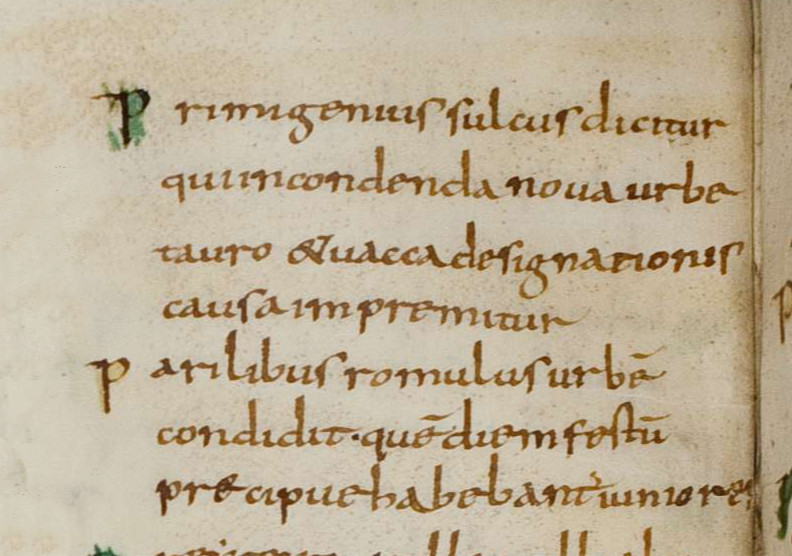


Comments